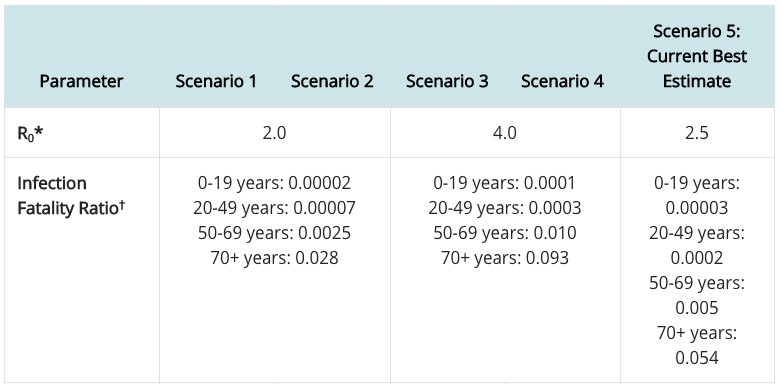|
In his recent skit, comedian JP Sears makes a big math blunder regarding the COVID death count. One I’ve made before.
Imitating a spokesperson of unclear affiliation, with tape on his glasses and a psychedelic T-shirt, JP starts off by poking fun at bizarre masking etiquette: “So I should put the mask on while I walk from here to podium and then take it off?”
Once at the mic, JP says: “We have updated numbers on the infection-fatality rate for COVID-19 directly from the CDC.” He then references the CDC’s most recent infection-fatality estimates, claiming that it says only 0.054% of people over 70 (who are infected with SARS-COV-2) are dying.
My immediate reaction was: “Whoa! That’s too low. Has the CDC gone from over-exaggerating the deaths to under-exaggerating?”
The commonly accepted fatality rate for the flu (among the general population) is 0.1%. Seniors should be higher than that, not lower. Looking at the source document, I saw JP’s error — he’s talking in percentages but CDC’s table clearly indicates ratios:

I made this same mistake in an article I wrote two months ago, where I calculated the infection-fatality rate in Canada. It was thanks to an email from Dr. Ron Brown PhD that I was able to spot and remove the error. As Brown said: “That decimal point is a killer! Just remember to move the decimal over TWO places to the RIGHT to convert [a ratio] to a percentage. (And TWO places to the LEFT to convert a percentage to a [ratio].)”
Here’s how I would explain the difference between a ratio and a percentage, using the above CDC estimate for those over 70:
A ratio is dealing with only just one infected person. For every ONE person infected with SAR-COV-2 the CDC is estimating that 0.054 will be having an permanent out-of-body experience.
But a percentage is showing how many will die out of ONE-HUNDRED infected (cent being Latin for one hundred). In order to arrive at a percentage from the ratio, the ratio needs to be multiplied by 100. Therefore, if 100 are infected that would mean 5.4 are doomed to die. 5.4%.
Yesterday, I sent an email to Prof. Denis Rancourt PhD to confirm whether or not I had indeed spotted an error. His to-the-point reply: “Yes, JP f*cked up. He took the CDC ratios to be percentages.”
Like I said, I did the same mistake a month or so ago. I would ask that JP Sears do what I did: Remove the error. In this case, delete the video. Make a new one. Even if you go with the higher percentages, a 5.6% fatality rate for seniors over 70 doesn’t justify destroying a nation. A 2003 study in Clinical Infectious Disease, for example, cites flu fatality rates as high as 25% for elderly people in nursing homes — and an average of 8%.
JP’s a skilled comedian. He can make an even funnier video without having to falsify what the CDC says. Just like his clever janitorial skit or his brilliant video about staying healthy in 2020. His satirical work is invaluable for helping change the not-so-funny direction the world is headed.
*
Note to readers: please click the share buttons above or below. Forward this article to your email lists. Crosspost on your blog site, internet forums. etc.
John C. A. Manley has spent over a decade ghostwriting for medical doctors, as well as naturopaths, chiropractors and Ayurvedic physicians. He publishes the COVID-19(84) Red Pill Briefs – an email-based newsletter dedicated to preventing the governments of the world from using an exaggerated pandemic as an excuse to violate our freedom, health, privacy, livelihood and humanity. He is also writing a novel, Brave New Normal: A Dystopian Love Story. Visit his website at: MuchAdoAboutCorona.ca. He is a frequent contributor to Global Research.
All images in this article are from the author
|